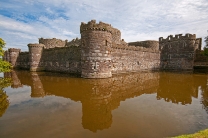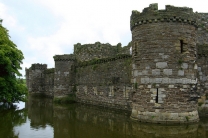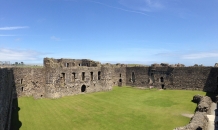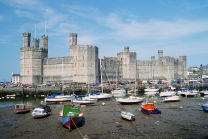Beaumaris Castle
No video yet

Beaumaris Castle
Beaumaris Castle (Welsh: Castell Biwmares), in Beaumaris, Anglesey, Wales, was built as part of Edward I's campaign to conquer the north Wales after 1282. Plans were probably first made to construct the castle in 1284, but this was delayed due to lack of funds and work only began in 1295 following the Madog ap Llywelyn uprising. A substantial workforce was employed in the initial years under the direction of James of St George. Edward's invasion of Scotland soon diverted funding from the project, however, and work stopped, only recommencing after an invasion scare in 1306. When work finally ceased around 1330 a total of £15,000 had been spent, a huge sum for the period, but the castle remained incomplete.
Beaumaris Castle was taken by Welsh forces in 1403 during the rebellion of Owain Glyndŵr, but recaptured by royal forces in 1405. Following the outbreak of the English Civil War in 1642, the castle was held by forces loyal to Charles I, holding out until 1646 when it surrendered to the Parliamentary armies. Despite forming part of a local royalist rebellion in 1648, the castle escaped slighting and was garrisoned by Parliament, but fell into ruin around 1660, eventually forming part of a stately home and park in the 19th century. In the 21st century, the ruined castle is still a tourist attraction.
Historian Arnold Taylor described Beaumaris Castle as Britain's "most perfect example of symmetrical concentric planning". The fortification is built of local stone, with a moated outer ward guarded by twelve towers and two gatehouses, overlooked by an...











